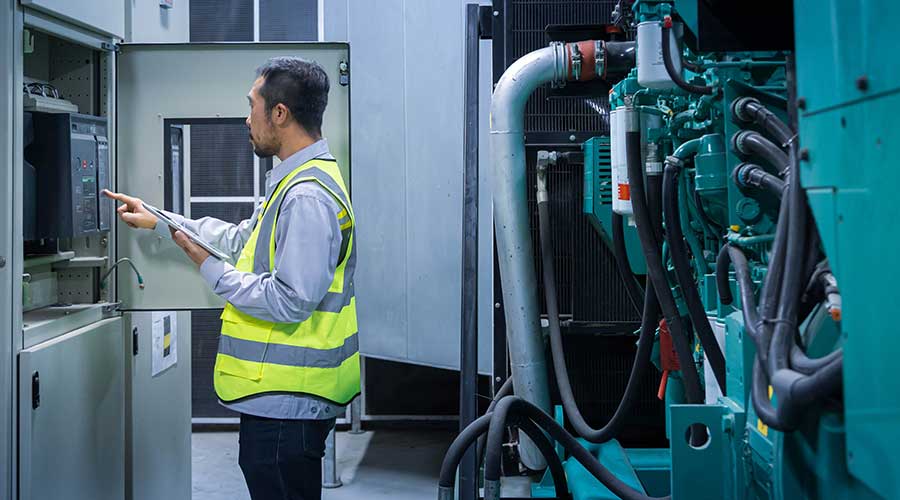Hospitals and other healthcare facilities are in flux, and the changes in nearly every aspect of their operations demand that facility managers take a holistic approach to ensuring the reliability and performance of emergency power supply systems (EPSS).
Given the challenges related to smart technology, greater scrutiny from regulatory bodies and the need to find technicians with appropriate skills, managers and front-line technicians must take some important steps to actually manage EPSSs instead of merely operating them.
Facilities and systems evolve
The evolution of healthcare facilities means managers need to remain vigilant about setting priorities, allocating resources and ensuring EPSSs meet the changing needs of medical professionals and patients through inspection, testing and maintenance (ITM).
"In recent years, the requirements for the inspection, testing, and maintenance of emergency power supply systems in healthcare facilities have evolved significantly under CMS guidelines and NFPA 99 and NFPA 110 codes, paralleling advancements in technology across various critical areas,” says Chris Haas, director of life safety and compliance with Medxcel, pointing to areas such as data centers, pharmacies, operating rooms and other essential equipment.
As an example, Haas points to the integration of increasingly sophisticated monitoring and diagnostic tools, which enable real-time data analysis and predictive maintenance and reduce the likelihood of system failures.
“This technological progression has necessitated updates in regulatory standards to confirm that healthcare facilities not only implement but also maintain these advanced systems effectively,” he says.
The expanded requirements affect other areas essential to managers.
“Regulatory bodies have also introduced more comprehensive documentation requirements, ensuring that facilities maintain meticulous records of all inspection, testing and maintenance activities, thus facilitating better compliance and accountability,” he says.
Amy Nunziata, executive vice president of operations with JLL's healthcare work dynamics division, says the Joint Commission has placed greater emphasis on NFPA 110, which considers the entire EPSS.
“It's not just the generator itself; it's the entire system,” she says. “There's a lot of focus on the entire system, the environment that it's in, the fuel tanks, emergency lighting and the like."
Technician considerations
The ITM process for EPSSs in healthcare facilities also puts a great deal of responsibility on the shoulders of front-line technicians. While the tasks in the process are thoroughly documented, Nunziata says technicians need to pay special attention to a range of critical areas.
"Some of the techs would think that the requirement is to run a generator on a weekly basis,” she says. “The requirement is not to run it on a weekly basis. It's to inspect it on a weekly basis. The requirement is to run it on a monthly basis.”
She also says technicians also must pay close attention when recording times for automatic transfer switches (ATS).
"With total runtime — including when you run the generator on monthly basis, when you run the generator up to 30 percent — you have to get to 30 percent of the nameplate rating of the generator,” she says. “You have to make sure that you not only record that 30-minute time, but the time to ramp up and the time to cool down. It's not just the 30 minutes.”
Haas recommends that because of the complexities of EPSSs, technicians also should remain committed to a preventive maintenance program for all system components because it enables them to effectively assess and maintain them.
“Technicians should also closely follow manufacturer recommendations, which provide specific maintenance guidelines and operational checks tailored to each system,” he says, adding that “referencing NFPA 99 and NFPA 110 standards is crucial as these documents outline the safety and performance requirements for healthcare facilities' electrical systems.”
Management challenges
Facility managers face their own set of challenges in ensuring a successful ITM program for EPSS in healthcare facilities. Among the toughest challenges is working successfully with a range of affected parties through facilities and beyond.
“Understanding all of your stakeholders who are affected by it can be a challenge,” Nunziata says. “A lot of times, this work is done on a weekend or maybe early in the day. A lot of times, the one area that's most impacted is your OR schedule. Oftentimes, your ORs start later in the day, later in the morning. You could do your generator test them.
“Trying to figure out what the best time for everyone is probably the biggest challenge because it's also a resource issue for the facilities teams. When can they get their mechanics there to do this testing?”
In many cases, coordinating these activities also needs to involve the surrounding community.
"In an urban environment, consider your neighbors,” she says. “It may be convenient for your hospital to do it at 3 in the morning, but your neighbors are going to go bananas. It's just like the picking up the Dumpster in the middle of the night.”
Haas says the strict interval requirements for EPSS testing are not challenges only for technicians. They require meticulous tracking and planning on the part of managers to ensure compliance.
“Maintaining comprehensive documentation to demonstrate adherence to these guidelines further complicates the process, requiring time-intensive record-keeping and coordination,” he says. “Balancing these demands across multiple departments with differing operational priorities demands strategic planning, robust communication and a thorough understanding of each area's specific needs and constraints.”
Nunziata and Haas point to the growing role of data gathering and analysis in the overall success of an EPSS program. For managers, the expanded role means placing a greater emphasis on gathering accurate, up-to-date and complete data.
“If you cannot document that you did it, it did not happen,” Nunziata says. “The form that you used 10 years ago to do the weekly and monthly testing of your generators is different today. The surveyors, whoever comes in to survey you, they've upped their game, and they know what to look for because there's been so much focus on emergency power systems and failures and why failures occur. Making sure that your documentation is very, very specific is crucially important.”
What data should managers focus on?
"Key data types include operational performance metrics, such as generator run times, load levels during testing and response times during power outages, which help assess how well the system performs under different conditions,” Haas says. “Maintenance records are crucial, providing detailed logs of scheduled preventive maintenance, repairs, and inspections to identify trends and confirm regulatory compliance.”
Mistakes and myths
Given the complexity of ITM activities for EPSS and the changing nature of facilities, it should be no surprise that managers and technicians make mistakes along the way and might not have a complete understanding of all components in the process.
Nunziata points to fuel quality as one example, noting that organizations are required to test fuel for generators annually.
“Fuel quality issues are something that definitely comes up. You should really pay attention to those fuel quality results. It's not just getting the test. It's actually looking at it and seeing if there are things that need to happen.”
ATSs also can cause problems for technicians.
"When you switch your ATSs, do they automatically switch back to normal power at the end of the generator test?” she asks. “The reason you test these is to make sure they switch to emergency power, as well as back off of emergency power. That's definitely an issue.”
Despite the comprehensive nature of each part of ITM programs, technicians still can find major problems with components.
“Failed equipment is a critical concern, with technicians often finding malfunctioning components such as generators, transfer switches or batteries that have not been properly maintained or replaced,” Haas says.
Beyond mistakes, the process of maintaining EPSS also comes with myths and misconceptions that prevent managers from implementing a fully effective program. As an example, Nunziata points to a manager’s perceptions about technicians’ skill sets.
"Team competency is something to not assume,” she says. “Do your technicians really understand the systems that they're maintaining? Send them for training. It could be in house. It could be your chief engineer training all of the technicians that are involved in the testing process. You can also bring in the manufacturer for the generator, the manufacturer for the ATS systems to make sure that everyone understands.
“They're not just checking a box. They need to really, truly understand the system that they are testing and maintaining. Don't make an assumption that everyone knows. Get them training. It will pay off in such dividends.”
Haas says managers also need to revisit their beliefs about the overall priorities and demands related to ITM and not assume that all EPSS components have the same testing frequency.
“Different components have specific requirements that must be adhered to for optimal performance,” he says. “There is often a belief that existing systems are inherently compliant without regular review and updates, which can lead to potential safety risks and regulatory violations. Understanding these misconceptions is vital for healthcare managers to uphold the safety and reliability of their facilities' emergency power systems.”
Dan Hounsell is senior editor for the facilities market. He has more than 30 years of experience writing about facilities maintenance, engineering and management.

 Contaminants Under Foot: A Closer Look at Patient Room Floors
Contaminants Under Foot: A Closer Look at Patient Room Floors Power Outages Largely Driven by Extreme Weather Events
Power Outages Largely Driven by Extreme Weather Events Nemours Children's Health Opens New Moseley Foundation Institute Hospital
Nemours Children's Health Opens New Moseley Foundation Institute Hospital Code Compliance Isn't Enough for Healthcare Resilience
Code Compliance Isn't Enough for Healthcare Resilience Ribbon Cutting Marks First Phase Completion for New Montefiore Einstein Facility
Ribbon Cutting Marks First Phase Completion for New Montefiore Einstein Facility